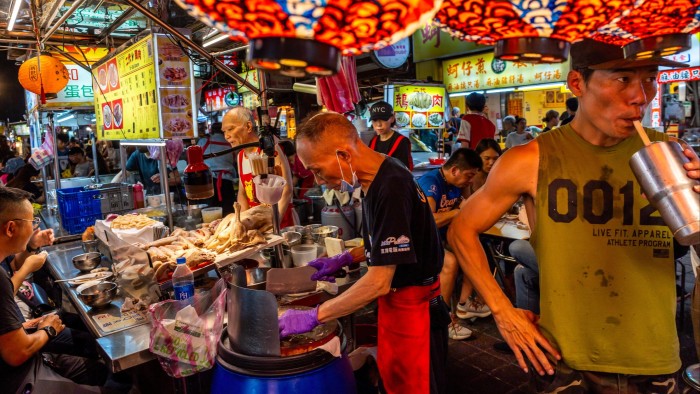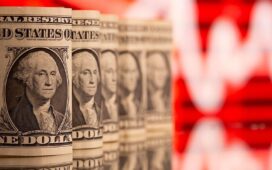Asian investors have been rushing to shield themselves from big swings in the US dollar, putting upward pressure on their local currencies and forcing Hong Kong authorities to intervene in the market.
Taiwan’s dollar has surged almost 6 per cent against the greenback this month, posting the biggest single-day moves since the 1980s, while Hong Kong’s monetary authority spent the largest weekly amount since 2020 to stop the city state’s currency strengthening beyond a US dollar peg.
“It is not even once in a decade — it has been a once in a lifetime event. It has been an extraordinary move” in the Taiwan dollar in particular, said Mark Ledger-Evans, a portfolio manager at emerging markets investment firm Ninety One.
The moves reflected uncertainty over what Chinese manufacturers, Taiwanese insurers and other Asian investors will do with the trillions of dollars of US assets built up due to surging exports to the US. These assets are now hostage to a weakening greenback.
While central banks have theoretically unlimited firepower to fight these moves by using their currencies to buy up dollars, many are reluctant to be tagged as a “currency manipulator” — a label given by the Trump administration to China in 2019 — by the US as they try to persuade it to lower trade tariffs.
Taiwanese markets in particular, Ledger-Evans said, had been hit by a “perfect storm” triggered by speculation that US trade talks would result in a stronger local currency. Investors rushed to buy domestic stocks and sell American bonds held via local funds, dumping the greenback and hitting one of the biggest, and least hedged, dollar piles of any Asian economy.
Over the past decade, Taiwan’s life insurance companies built up a roughly $700bn pile of dollar investments, according to analyst estimates, nearly as large as the country’s GDP, as they looked abroad to higher bond yields than at home in order to help them pay out on policies and attract savers.
Along with assets held by the central bank and other investors, this made the island nation a top-ten international holder of US Treasuries and US corporate bonds, owning approximately 4 per cent of foreign holdings in both, according to JPMorgan.
To benefit from dollar rates, and to avoid the costs of hedging, insurers opted not to protect about one-third of these assets against currency moves, according to analyst estimates.
But after the recent sharp currency swings, buying a hedge is more expensive. At the start of this week the cost of hedging moves in the Taiwan dollar over the next month, using forward contracts in which no physical settlement takes place, rose as high as 24 per cent, well above its usual level.
Stephen Jen, chief executive of hedge fund Eurizon SLJ, said in a note that exporters in China, Taiwan, Malaysia and Korea were collectively holding trillions of US dollars offshore that could be repatriated, which would cause an “avalanche” of rising local currencies.
“We are still waiting for more triggers, but we see the sharp sell-off in [the US dollar against the Taiwanese dollar] this week from this avalanche perspective. We predict there will likely be other sudden lurches lower in [the US dollar against Asian currencies],” he wrote.
However, some investors believe this is unlikely as long as trade surpluses are still producing US dollars that need to be recycled into markets.
A treasurer at one large Taiwanese life insurer said they believed the central bank allowed the currency appreciation as part of trade negotiations between the US and Taiwan. Taiwanese officials have insisted the US has not asked for such a currency move.
“We will keep hedging . . . but are not selling our US dollar assets,” the treasurer said.
The US Treasury has defined a “currency manipulator” as a country spending more than 2 per cent of its GDP on intervention over a 12-month period, in addition to large trade surpluses. This, say analysts, means the Taiwanese central bank could buy up to $16bn in dollars to weaken the currency if needed while avoiding the US label.
In Hong Kong, which maintains a so-called linked exchange rate system — a trading band between HK$7.75 and HK$7.85 to the dollar in which the currency can trade — forward contracts are showing some traders are betting the Hong Kong dollar will strengthen out of the band for the first time since 2020.
Hong Kong’s monetary authorities have intervened to buy close to $17bn since May to stem the appreciation of the Hong Kong dollar, according to HKMA data. Much of its rise has been driven by large inflows, in part from mainland Chinese investors, into the local capital markets to buy listings such as that of battery maker CATL.
The South Korean won hit a six-month high on Wednesday of 1,387.95 per dollar amid optimism over trade talks with the US leading to lower tariff levels.
Rhee Chang-yong, Bank of Korea governor, warned that volatility in Asian currencies would continue as long as uncertainty over global trade persisted.
“Asian currencies have strengthened recently on expectations for some kind of agreement in US-China talks. But no one knows what is happening in the talks,” he told reporters on Monday. “Therefore, volatility will continue.”
Additional reporting by Robin Harding, Haohsiang Ko and Jung-a Song





